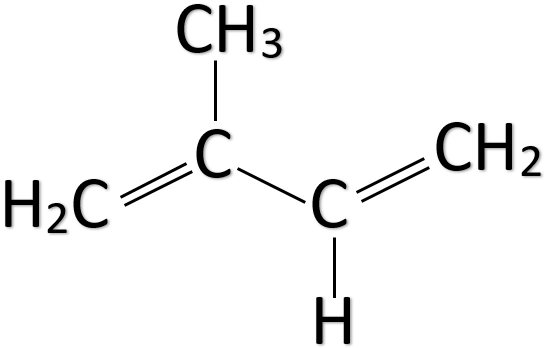
The natural rubber is the polymer of:
A. 1,3-butadiene
B. Polyamide
C. Isoprene
D. None of the above.
Answer
516.9k+ views
2 likes
Hint: The monomer of natural rubber is chemically known as 2-methyl-1,3-butadiene.
Complete answer:
Natural rubber is a polymer of isoprene. The chemical name of isoprene is 2-methyl-1,3-butadiene and its chemical formula is

Natural rubber is also known as latex, Caucho, Indian rubber, caoutchouc, and Amazonian rubber. The major source of natural rubber which is used commercially is the Amazonian rubber tree. Previously natural rubber was mostly extracted from the Congo rubber tree.
Additional Information: Natural rubber is an example of elastomer. Elastomer, as the name suggests is a polymer that has elastic properties. That is, it can return to its original shape after it is deformed or stretched. This property of elastomers comes from the ability of the rubber to stretch apart the chains and when the tension is released, the chain can come back to its original position.
As we know that isoprene has two double bonds, when it is polymerised it retains one of the double bonds. By mixing sulphur and rubber, the properties of rubber such as toughness, elasticity, heat, and cold resistance are increased. This process is known as vulcanization. The vulcanization of rubber causes the shorter chains to link in a crossed way with the longer chains through the sulphur.
Note: Don’t confuse isoprene with 1,3-butadiene as given in option A. Isoprene is 2-methyl-1,3-butadiene and as we can see, it has an extra methyl group linked with the second carbon of 1,3-butadiene.
Complete answer:
Natural rubber is a polymer of isoprene. The chemical name of isoprene is 2-methyl-1,3-butadiene and its chemical formula is

Natural rubber is also known as latex, Caucho, Indian rubber, caoutchouc, and Amazonian rubber. The major source of natural rubber which is used commercially is the Amazonian rubber tree. Previously natural rubber was mostly extracted from the Congo rubber tree.
Additional Information: Natural rubber is an example of elastomer. Elastomer, as the name suggests is a polymer that has elastic properties. That is, it can return to its original shape after it is deformed or stretched. This property of elastomers comes from the ability of the rubber to stretch apart the chains and when the tension is released, the chain can come back to its original position.
As we know that isoprene has two double bonds, when it is polymerised it retains one of the double bonds. By mixing sulphur and rubber, the properties of rubber such as toughness, elasticity, heat, and cold resistance are increased. This process is known as vulcanization. The vulcanization of rubber causes the shorter chains to link in a crossed way with the longer chains through the sulphur.
Note: Don’t confuse isoprene with 1,3-butadiene as given in option A. Isoprene is 2-methyl-1,3-butadiene and as we can see, it has an extra methyl group linked with the second carbon of 1,3-butadiene.
Latest Vedantu courses for you
Grade 11 Science PCM | CBSE | SCHOOL | English
CBSE (2025-26)
School Full course for CBSE students
₹41,848 per year
Recently Updated Pages
Master Class 12 Biology: Engaging Questions & Answers for Success

Master Class 12 Physics: Engaging Questions & Answers for Success

Master Class 12 Economics: Engaging Questions & Answers for Success

Master Class 12 Maths: Engaging Questions & Answers for Success

Master Class 4 Maths: Engaging Questions & Answers for Success

Master Class 4 English: Engaging Questions & Answers for Success

Trending doubts
Give 10 examples of unisexual and bisexual flowers

Draw a labelled sketch of the human eye class 12 physics CBSE

a Tabulate the differences in the characteristics of class 12 chemistry CBSE

Differentiate between homogeneous and heterogeneous class 12 chemistry CBSE

Why is the cell called the structural and functional class 12 biology CBSE

Differentiate between insitu conservation and exsitu class 12 biology CBSE




